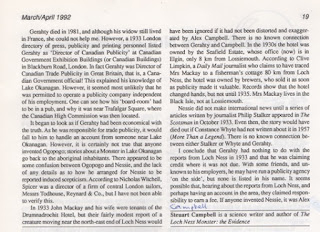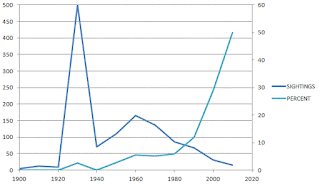It is the constant refrain of the sceptical - "Where is the conclusive film or photograph?". Having "jousted" with such people over the years on this subject and replied in various articles, there is no need to repeat long arguments and replies.
However, the sceptical demands for evidence are brought into contemporary relief by the advent of mobile phone cameras and the supposed deduction that this ought to produce something game changing. My previous replies to that suggests it is not as clean cut and wrinkle free as they make out.
A further look at the recent sightings database reveals more. I produced the graph below for the aforementioned article to demonstrate that image capture was on the increase due to such technology. The proportion of images taken in relation to the total number of reported sightings has increased substantially since the 1980s with at least 50% of reports carrying a film or photo.
However, that is not enough for the critics. They want an irrefutable image which would somehow get past the accusations of "Fake" and "CGI". Setting aside the issues of how exactly a photo is deemed fake-free or non-CGI, one thing is certain and that is the Loch Ness Monster would have to be pretty close and well out of the water to produce such a compelling image. Here begins the problems. I charted the number of historical sightings which were less than 100 yards or meters from the witness and got this graph.
As you can see, close up reports of Nessie have been on the decline since the 1970s. To put it plainly, if the monster is not playing ball by putting in a close appearance, no amount of fancy or expensive HD ready mobile phones will capture anything that could be called game changing.
Accept it, as they say.
You won't? Okay, let's take a closer look. The question is why close up reports have declined? This is not surprisingly part of a general decline in sightings, for which I drew up a list of possible reasons in an earlier article:
- People are less easily fooled by natural loch phenomena.
- People are less motivated to report sightings in a sceptical age.
- People find it harder to find an "official" centre to report sightings.
- The media does not report as many sightings as it used to.
- The creature(s) is surfacing less often either due to population decline.
- The creature(s) is surfacing less often due to aversion to increased surface activity.
- Reports from recent years have still to filter through to researchers.
To be clear, though, the absence of close encounters with Nessie at a hundred paces is not going to be explicable by all these categories. For example, the first explanation is not so convincing for close up encounters, I quite frankly get bored with people who insist witnesses mistook a cormorant for a monster at sixty feet. You can only dumb down witnesses so far.
In fact, of these seven speculations, I would think only 5 and 6 are relevant as I can't imagine a close up view of Nessie not making it into the media mainstream. In fact, the bottom line is that sightings of the calibre of MacLean, Jenkyns, Cockrell and so on have just not happened in recent years.
I would add a modifier to option 5 and that is the travelling Nessie hypothesis. As opposed to population decline due to overfishing and pollution, perhaps the Loch Ness Monster has just vacated the premises? Since the sightings record indicates at least three or more creatures seen at one time, the population in the loch is not so dependent on breeding but on new creatures every few decades coming in to replenish the numbers. Whether they can leave again is a matter of debate and an article in its own right.
But we do have sightings which have occurred within 100 metres of the witness, but whatever was seen was just below the surface or barely showing. One example is the photo taken by Jon Rowe in 2011. There may be one or two others but they involve water disturbances rather than a full show of the creature.
Which brings me to a comment posted a while back on the matter of how many films and photos should we have of the Loch Ness Monster. That word "should" is pretty loaded as it can carry a lot of bias generated assumptions with it. Their reasoning went as follows:
"Ok let's show mathmatically the minimum since 2005, because I have read a
stat that 90% of adults since 2005 have carried a mobile phone with a
camera, averaged over the last 10 years. This seems reasonable,
certainly not far off the mark in terms of everyday observations. In
2015 it is higher than 90%, in 2005 it was lower. So for argument's sake
we will both ignore the years before 2005, and we will not factor in
the multitude of digital cameras and video cameras (inc night vision)
taken to the loch additionally.
Next we need to know how many
sightings lasting more than 10 seconds have occurred since 2005. We are
told that this figure is down to about 3 a year.
So doing the
maths, there should have been 30 sightings of more more than 10 seconds,
and 90% of these should have been filmed. We should have 27 films worth
looking at since 2005, and dozens more from before then. Of these 27,
if they were all clear views of Nessie, they would all produce footage
worth analysing.
Now, your turn to justify why we have ZERO instead"
So, our commenter is expecting 27 films of the Loch Ness Monster since 2005 - and he thinks I expect zero. The first thing to do is ascertain how many sightings have actually been logged in the ten year period up to 2015. Consulting my own articles as well as the
database maintained by Gary Campbell, I have come up with at least 24 recorded events as opposed to the 30 assumed by the commenter. In this, I have excluded webcam reports, sonar contacts and Google Earth map stories.
How many resulted in films or photos? Our commenter applies a 90% ratio to get 27 image captures and for some reason he expects them all to be motion and not still images. As it turns out, the number is 13, 11 of these were photos and 2 were film. That is an image/report ratio of 54%. Three of the cases involved driving in a car and three were in boats. If the car drivers are removed as potential camera users, the ratio increases to 62%. The list is shown below:
2005 - 4 (Bell, Yeats, Anonymous(b), Girvan(p))
2006 - 1 (Murphy(d))
2007 - 2 (Wilson(bp),Holmes(f))
2008 - 1 (Ellis(p))
2009 - 1 (MacDougall)
2010 - 1 (Preston(p))
2011 - 4 (Rowe(p),Hargreaves,Gruer,Jobes(p))
2012 - 2 (Assleman(p),Ross(p),Anonymous(d))
2013 - 0
2014 - 3 (gamekeeper,Loch Ness Lodge staff(p),Bhardwaj(bp))
2015 - 5 (Ross(f),Anonymous,Bruce(d),Bates(p),McKenna(d))
d=driving
b=boating
p=photo
f=film
Those are the numbers and I would not class any of them as a close up view of a fully exposed monster. Indeed, some reports will be too far for such a situation. So that means I do expect films and photos but I (at this point in time) expect no game changers. There are others things to note.
The first is that even monster researchers will not accept every sighting as a bona fide sighting of Nessie. Some are going to be misidentification, though these will tend to be the ones which are much further away or only seen briefly before a proper assessment could be made of the object in question.
Secondly, witnesses prefer taking photos than films. As much as sceptics fume at dumb witnesses not switching their phones or cameras to video mode, it just doesn't happen the way they want it. The raw data says that 15% of images taken are motion and not the idealistic 100% of our commenter.
Where does this leave us? That sceptics expect films is not to be denied. The problem is the old girl is not putting in the required close up appearances. They say this is because such "
sightings" do not happen now because witnesses are better educated and not so easily fooled. I say prove it and how on earth does that apply to close ups at 100 metres where doubts over what you are seeing should be minimal.
Rather than accept these arguments, consider the possibility that the Loch Ness Monster is just not surfacing as much as it used to. Whether that is due to increased surface activity or population decline or just due to some of the monsters vacating the loch is now a matter of debate.
The author can be contacted at lochnesskelpie@gmail.com






